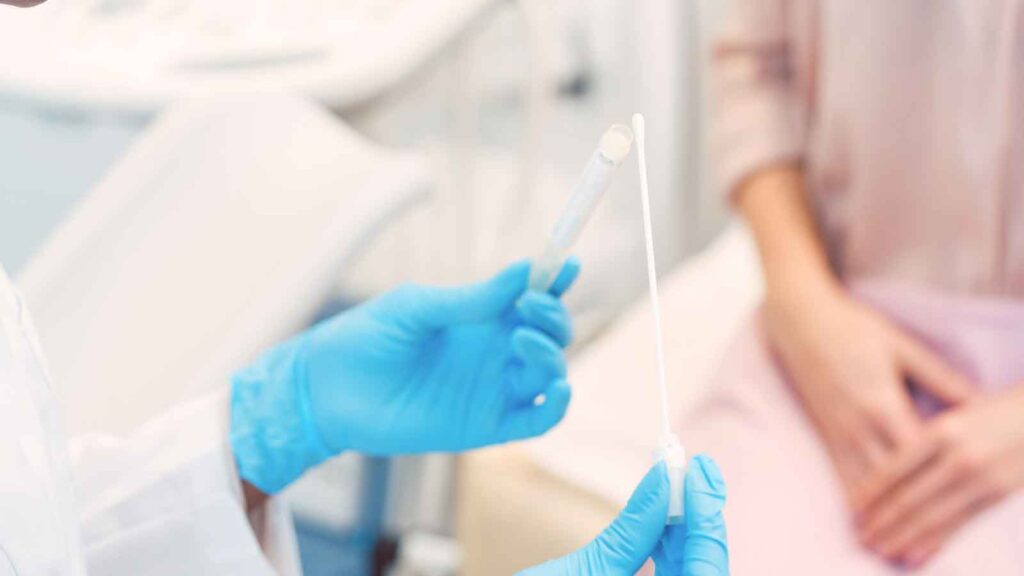Maintaining your cervical health is essential to your overall well-being, and regular pap smears play a crucial role in early detection and prevention of cervical cancer. This simple yet powerful screening test has helped significantly reduce cervical cancer mortality rates, making it an indispensable part of women’s healthcare.
But how often should you get a pap smear, and why does it matter? In this guide, we’ll break down the purpose of the pap smear test, the recommended screening schedules, and its importance in safeguarding your reproductive health.
What is a Pap Smear?
A pap smear, or pap test, is a routine screening procedure to detect abnormal changes in cervical cells. These changes may indicate the presence of precancerous cells or infection with the human papillomavirus (HPV), a leading cause of cervical cancer. This non-invasive procedure is typically performed during a pelvic exam and takes only a few minutes to complete.
Regular pap testing is an essential aspect of preventive healthcare for women, enabling early detection and timely intervention for cervical health concerns.
Purpose of a Pap Smear
A pap smear procedure plays a crucial role in safeguarding reproductive health. It is a cornerstone of preventive care, serving two primary purposes: early detection of abnormal cervical cells and screening for HPV-related changes.
Early Detection of Abnormal Cervical Cells
The primary goal of a pap smear test is to identify abnormal cervical cells before they progress into more serious conditions, such as cervical cancer. Many abnormalities develop gradually over time, and routine screening allows healthcare providers to detect and address these changes at a precancerous stage.
- Why early detection matters: Cervical cancer often develops silently, with symptoms appearing in later stages when treatment is more complex. Routine pap smear testing helps identify irregularities when they are most manageable.
- Actionable outcomes: Early detection provides an opportunity to implement effective treatments, preventing the condition from escalating.
Screening for HPV-Related Changes
In addition to detecting abnormal cervical cells, Pap smears play a role in identifying early signs of HPV-related changes. HPV (human papillomavirus) is a common sexually transmitted infection, and certain strains can lead to cervical abnormalities over time. By catching these changes early, healthcare providers can take preventive steps to safeguard your reproductive health.
- Why HPV screening matters: Some high-risk HPV strains can cause cell changes that may develop into cervical cancer if left untreated. Regular Pap smears help monitor these changes, allowing for timely follow-up and care.
- Combined testing for accuracy: In some cases, Pap smears are paired with HPV testing to provide a more comprehensive assessment of cervical health, particularly for women over 30.
Proactive screening ensures any abnormalities are identified and addressed before they become serious health concerns. Staying consistent with routine exams empowers you to maintain long-term reproductive wellness and peace of mind.
How the Test Works
The pap smear procedure is straightforward and prioritizes patient comfort while providing crucial insights into cervical health. Understanding how the test works can help alleviate concerns and encourage women to undergo regular screenings. Below is a step-by-step breakdown of the procedure:
Preparation for the Test
Before the procedure begins, your healthcare provider ensures a comfortable and relaxed environment. You may be asked to undress from the waist down and provided with a drape for modesty. Lying on an examination table, you will place your feet in stirrups to allow the provider clear access to the cervix.
Step-by-Step Process of a Pap Smear
1. Visual Examination
The healthcare provider examines the vaginal area and cervix to assess overall health. This visual check ensures there are no apparent abnormalities or concerns before proceeding with the sample collection.
2. Speculum Insertion
A speculum, a medical instrument used to widen the vaginal walls gently, is inserted to provide a clear view of the cervix. This part of the procedure might feel slightly uncomfortable but should not be painful.
3. Sample Collection
- The healthcare provider carefully collects a sample of cervical cells using a small, soft brush or spatula.
- The collection process is quick, typically lasting only a few seconds. Patients might feel a light scraping sensation, but it is generally painless.
4. Securing the Sample
The collected cervical cells are placed in a preservative solution or smeared onto a slide. This ensures that the sample remains intact for accurate analysis.
5. Lab Analysis
The sample is sent to a laboratory, where it is examined for any abnormal cell changes or the presence of high-risk HPV strains. Lab technicians use advanced screening methods to identify potential issues that may require further attention.
The Role of the Provider During the Test
Healthcare providers play a vital role in ensuring the procedure is smooth and stress-free. They communicate each step of the process, addressing patients’ questions or concerns. This open communication helps reduce anxiety and ensures that patients feel informed and comfortable.
After the Procedure
The pap smear itself takes just a few minutes to complete, and patients can resume normal activities immediately afterward. Mild spotting or discomfort is rare but normal. The results are typically available within a few days to a week, and your healthcare provider will discuss them with you during a follow-up consultation.
By understanding how the test works, patients can confidently approach the procedure and prioritize their reproductive health through regular screenings.
Recommended Screening Guidelines
Understanding how often to undergo pap smear testing is essential for maintaining cervical health. Screening frequency depends on several factors, including age, overall health, and personal risk factors. By adhering to established guidelines, individuals can achieve a balance between effective monitoring and minimizing unnecessary procedures.
General Guidelines by Age
Regular pap smears are a cornerstone of preventative care. Following the recommended screening intervals ensures abnormalities are detected at their earliest stages while avoiding over-testing. These evidence-based recommendations help healthcare providers tailor patients’ care plans to their needs.
Ages 21–29
Individuals between 21 and 29 years of age are recommended to undergo a pap smear test every three years. This interval provides sufficient time to monitor cervical cell changes while reducing the stress and potential discomfort of frequent testing.
- Why three years? Cervical changes linked to HPV infections often resolve on their own in this age group without intervention. Frequent testing is not typically necessary unless there are additional risk factors or abnormal test results.
Ages 30–65
For individuals aged 30 to 65, there are two primary options for cervical cancer screening:
- Every five years with co-testing: Combining a pap smear with HPV testing provides a comprehensive look at cervical health. This method identifies high-risk HPV strains alongside abnormal cell changes, extending the testing interval to five years.
- Every three years with pap smears alone: This option is ideal for those who prefer not to undergo HPV testing or when co-testing is unavailable.
Both methods are effective at monitoring for abnormalities. The choice depends on patient preferences, availability, and healthcare provider recommendations.
Ages 65 and Older
For those 65 and older, screening may no longer be necessary if they meet specific criteria, including:
- A history of three consecutive normal pap smears or two negative co-tests within the last 10 years.
- There is no history of abnormal test results in the preceding 20 years.
- No personal risk factors, such as a weakened immune system or a history of cervical cancer.
However, patients with certain conditions or risk factors may still benefit from continued testing. Decisions should always be made in consultation with a healthcare provider.
Guidelines for High-Risk Individuals
Some individuals face a higher risk of developing cervical abnormalities and may require more frequent testing. These guidelines ensure that high-risk patients receive the vigilance their health demands.
High-Risk Factors
- A history of abnormal pap smear results: Patients with previously detected abnormalities may need closer monitoring to ensure that any changes are addressed promptly.
- HIV or weakened immune systems: Conditions that compromise the immune system can increase the risk of cervical cell abnormalities, making more frequent testing essential.
- Persistent high-risk HPV infections: Long-term infections with high-risk HPV strains significantly elevate the likelihood of cervical cancer. Regular screenings help manage these risks effectively.
Patients with these factors may be advised to undergo pap testing annually or as their healthcare provider recommends. Personalized care plans consider medical history, lifestyle factors, and specific risks.
Factors Influencing Frequency
The recommended frequency for pap tests is not universal and varies depending on individual circumstances. While general guidelines provide a solid foundation, factors like health conditions and lifestyle choices often require a more personalized approach. A tailored screening schedule ensures comprehensive care and early detection of abnormalities, offering peace of mind and better outcomes.
Health Conditions
Certain health conditions can increase the risk of cervical abnormalities, necessitating more frequent pap smear tests. Identifying and addressing these conditions proactively is essential for effective prevention and early intervention.
Impact of Health Conditions on Pap Smear Frequency
1. HIV and Autoimmune Conditions
A weakened immune system compromises the body’s ability to combat infections, including the human papillomavirus (HPV). Individuals with conditions like HIV or autoimmune disorders are at a higher risk for persistent HPV infections, which can lead to cervical abnormalities. Regular pap tests help monitor any changes closely.
- Why it matters: Early detection of abnormalities ensures timely intervention and reduces the likelihood of progression to cervical cancer.
- Recommendation: Patients with weakened immune systems may need annual screenings or more frequent testing based on their health provider’s advice.
2. Persistent HPV Infections
For individuals with a history of high-risk HPV infections, close monitoring is crucial. Persistent infections can increase the likelihood of cellular changes that may develop into precancerous or cancerous conditions if left unchecked.
- Why it matters: HPV is responsible for the majority of cervical cancer cases. Monitoring its impact on cervical cells can prevent severe outcomes.
- Recommendation: Co-testing with pap smears and HPV testing is often recommended for more precise surveillance.
Staying informed about how health conditions affect your screening needs empowers you to take control of your reproductive health. Regular communication with your healthcare provider ensures that your care plan aligns with your specific risks.
Lifestyle Factors
Your lifestyle choices significantly influence cervical health and determine how often you should undergo pap smear testing. Understanding these factors can help you make informed decisions to protect your reproductive health.
Key Lifestyle Factors to Consider
1. Smoking
Smoking has a detrimental impact on cervical health. It weakens the immune system’s ability to clear HPV infections and directly damages cervical cells, increasing the risk of abnormalities.
- How it affects you: Smokers are at a higher risk for cervical dysplasia (precancerous changes) and cervical cancer.
- What you can do: Quit smoking and ensure routine pap testing to monitor any cell changes caused by tobacco use.
2. Sexual History
The risk of HPV exposure rises with specific sexual behaviors, making regular screenings essential for individuals with:
- Multiple sexual partners.
- Unprotected intercourse.
- A history of sexually transmitted infections (STIs).
Why it matters: HPV is a common sexually transmitted infection and a leading cause of cervical cancer. Regular pap smears allow for early detection of HPV-related changes.
3. Other Risky Behaviors
Practices such as inconsistent use of protection or engaging in sexual activity at an early age can increase vulnerability to HPV. Being aware of these factors enables proactive steps toward maintaining reproductive health.
You and your healthcare provider can design a screening plan that meets your unique needs by considering both health conditions and lifestyle factors. Regular pap testing, combined with lifestyle modifications where necessary, is key to safeguarding cervical health.
Take Charge of Your Cervical Health with Comprehensive Pap Smear Services
Protecting your cervical health begins with routine screenings and timely follow-ups. Pap smears are a cornerstone of preventative care, offering early detection of abnormalities and providing peace of mind about your reproductive health.
Gwinnett OB/GYN specializes in providing compassionate and thorough care. From performing pap smear tests to offering follow-up procedures like colposcopy and biopsy, our experienced team ensures you receive the personalized attention you deserve. Whether it’s your first pap smear or part of your ongoing health management plan, we’re here to guide you every step of the way.
Why Choose Gwinnett OB/GYN?
- Over 45 years of trusted care in women’s health.
- Board-certified obgyn specialists committed to patient comfort and education.
- Advanced screening and diagnostic tools for comprehensive cervical health management.
- Personalized care plans tailored to your individual needs.
Don’t wait to prioritize your health. If you’re due for a pap smear or have questions about your cervical health, contact Gwinnett OB/GYN today. Our team is ready to provide expert guidance and compassionate care. Schedule your appointment online or call us directly to take the next step in protecting your well-being.



